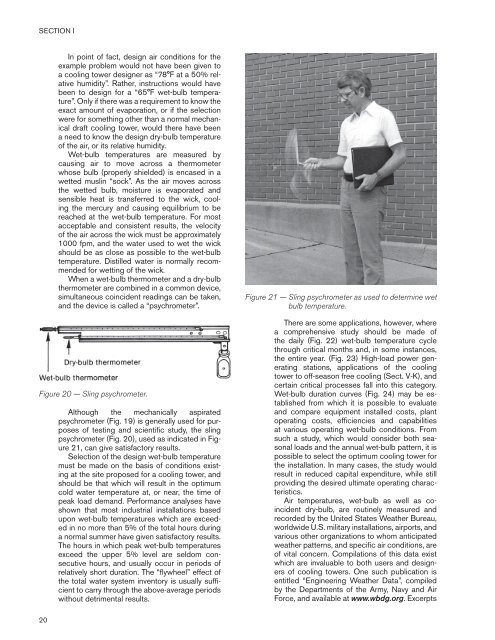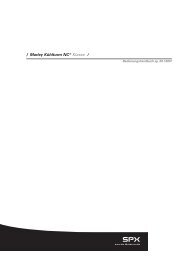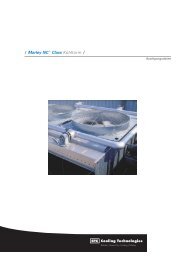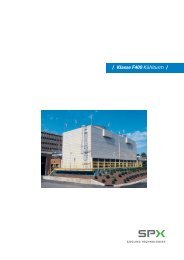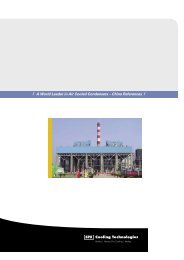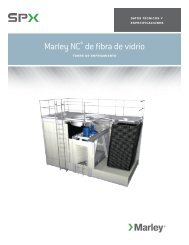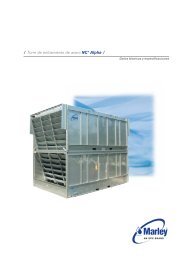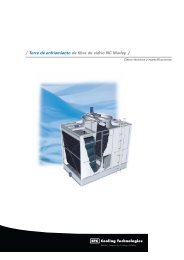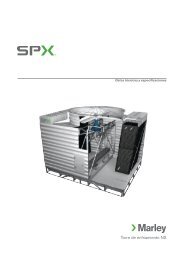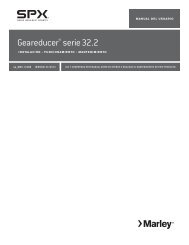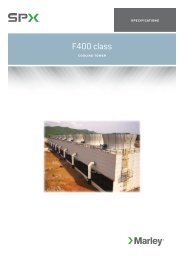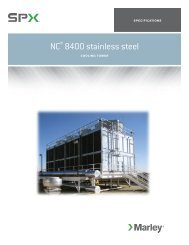Cooling Tower Fundamentals - SPX Cooling Technologies
Cooling Tower Fundamentals - SPX Cooling Technologies
Cooling Tower Fundamentals - SPX Cooling Technologies
Create successful ePaper yourself
Turn your PDF publications into a flip-book with our unique Google optimized e-Paper software.
SECTION I<br />
20<br />
In point of fact, design air conditions for the<br />
example problem would not have been given to<br />
a cooling tower designer as “78°F at a 50% relative<br />
humidity”. Rather, instructions would have<br />
been to design for a “65°F wet-bulb temperature”.<br />
Only if there was a requirement to know the<br />
exact amount of evaporation, or if the selection<br />
were for something other than a normal mechanical<br />
draft cooling tower, would there have been<br />
a need to know the design dry-bulb temperature<br />
of the air, or its relative humidity.<br />
Wet-bulb temperatures are measured by<br />
causing air to move across a thermometer<br />
whose bulb (properly shielded) is encased in a<br />
wetted muslin “sock”. As the air moves across<br />
the wetted bulb, moisture is evaporated and<br />
sensible heat is transferred to the wick, cooling<br />
the mercury and causing equilibrium to be<br />
reached at the wet-bulb temperature. For most<br />
acceptable and consistent results, the velocity<br />
of the air across the wick must be approximately<br />
1000 fpm, and the water used to wet the wick<br />
should be as close as possible to the wet-bulb<br />
temperature. Distilled water is normally recommended<br />
for wetting of the wick.<br />
When a wet-bulb thermometer and a dry-bulb<br />
thermometer are combined in a common device,<br />
simultaneous coincident readings can be taken,<br />
and the device is called a “psychrometer”.<br />
Figure 20 — Sling psychrometer.<br />
Although the mechanically aspirated<br />
psychrometer (Fig. 19) is generally used for purposes<br />
of testing and scientific study, the sling<br />
psychrometer (Fig. 20), used as indicated in Figure<br />
21, can give satisfactory results.<br />
Selection of the design wet-bulb temperature<br />
must be made on the basis of conditions existing<br />
at the site proposed for a cooling tower, and<br />
should be that which will result in the optimum<br />
cold water temperature at, or near, the time of<br />
peak load demand. Performance analyses have<br />
shown that most industrial installations based<br />
upon wet-bulb temperatures which are exceeded<br />
in no more than 5% of the total hours during<br />
a normal summer have given satisfactory results.<br />
The hours in which peak wet-bulb temperatures<br />
exceed the upper 5% level are seldom consecutive<br />
hours, and usually occur in periods of<br />
relatively short duration. The “flywheel” effect of<br />
the total water system inventory is usually sufficient<br />
to carry through the above-average periods<br />
without detrimental results.<br />
Figure 21 — Sling psychrometer as used to determine wet<br />
bulb temperature.<br />
There are some applications, however, where<br />
a comprehensive study should be made of<br />
the daily (Fig. 22) wet-bulb temperature cycle<br />
through critical months and, in some instances,<br />
the entire year. (Fig. 23) High-load power generating<br />
stations, applications of the cooling<br />
tower to off-season free cooling (Sect. V-K), and<br />
certain critical processes fall into this category.<br />
Wet-bulb duration curves (Fig. 24) may be established<br />
from which it is possible to evaluate<br />
and compare equipment installed costs, plant<br />
operating costs, efficiencies and capabilities<br />
at various operating wet-bulb conditions. From<br />
such a study, which would consider both seasonal<br />
loads and the annual wet-bulb pattern, it is<br />
possible to select the optimum cooling tower for<br />
the installation. In many cases, the study would<br />
result in reduced capital expenditure, while still<br />
providing the desired ultimate operating characteristics.<br />
Air temperatures, wet-bulb as well as coincident<br />
dry-bulb, are routinely measured and<br />
recorded by the United States Weather Bureau,<br />
worldwide U.S. military installations, airports, and<br />
various other organizations to whom anticipated<br />
weather patterns, and specific air conditions, are<br />
of vital concern. Compilations of this data exist<br />
which are invaluable to both users and designers<br />
of cooling towers. One such publication is<br />
entitled “Engineering Weather Data”, compiled<br />
by the Departments of the Army, Navy and Air<br />
Force, and available at www.wbdg.org. Excerpts


